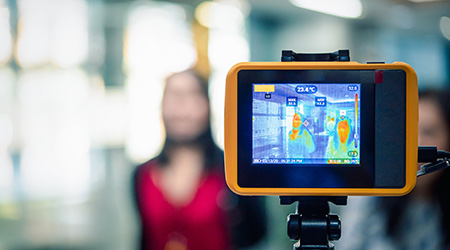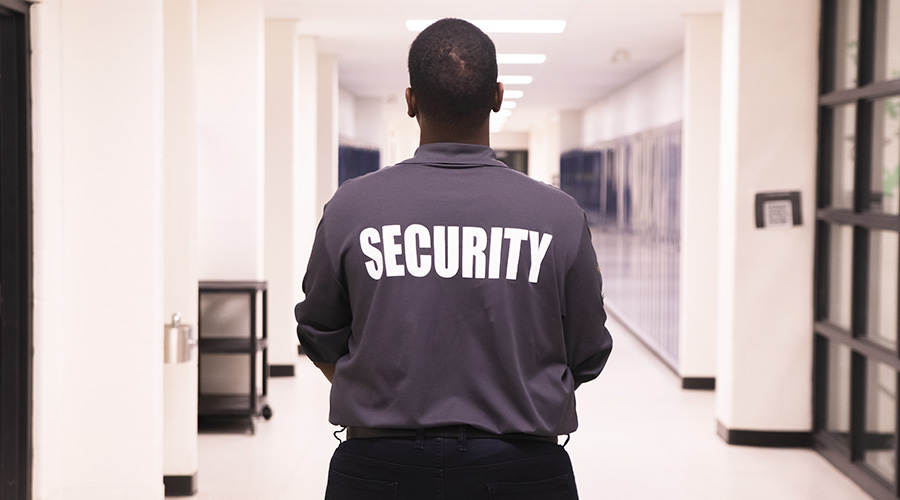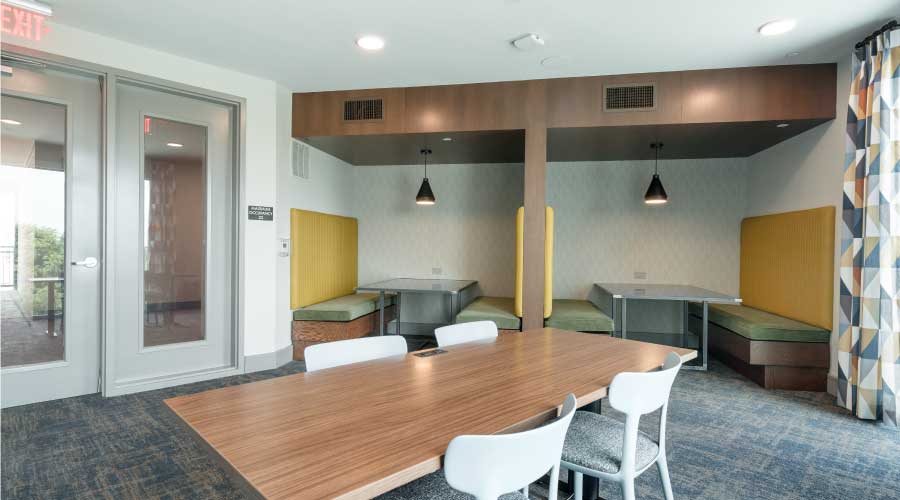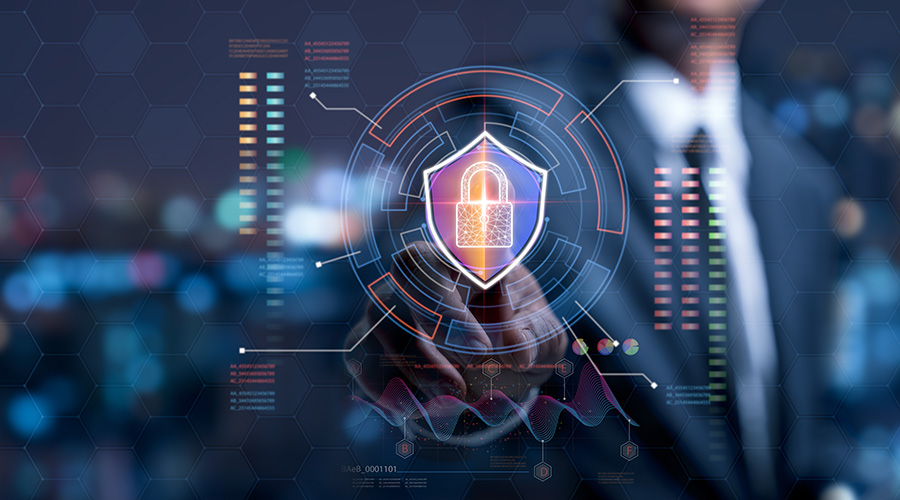Access Control: How to Balance Security with Health and Safety
As the pandemic continues to affect how occupants enter buildings, facility managers have to carefully consider how they'll implement access control procedures and equipment that are both secure and safe.
During the last several decades, the prevalence of school and workplace shootings, terrorist threats, and natural disasters have forced facility executives in institutional and commercial facilities to rethink and rework building management protocols to address building accessibility and security.
Americans have become used to, and now even expect, stringent access control policies and procedures. The pandemic has brought to the forefront the dangers that environmental issues – like poor air quality and flow and bacteria-prone materials — have on the health, safety, and wellbeing of its occupants.
In turn, the pandemic has affected the way facilities approach occupants entering the building. Many facilities have limited access areas into the building and require temperature checks before entering the buildings. Some companies are retrofitting common area spaces, like lobbies and vestibules, to improve air flow circulation and promote social distancing.
For building operators and facility managers, the question of how to create a proper mindset and protocol to deal with building safety is top of mind by emerging COVID-19 variants. The changing landscape of building access points, the industry demands that are impacting this shift and the evolving role that both technology and staffing have had on screening and building access points are all important factors in grasping a better understanding of security and screening access control best practices.
Industry demands
Prior to the enactment of the Architectural Barriers Act of 1968, not much thought or regulatory oversight was given on the accessibility of a building entrance and exit points. The landmark Americans with Disabilities Act (ADA) passed in 1990 also established the Standards for Accessible Design, which provides a framework and detailed guidance for making both new and historic buildings accessible. Wider and clearer door widths, sophisticated door hardware solutions like maglocks and the implementation of emergency exits and response plans are all common accessibility requirements that have shaped physical access control of a building.
The enforcement of ADA, combined with the prevalence of active-shooter events, environmental forces, patient wandering and elopement and even employee strikes and demonstrations in recent decades have put more accountability on employers and building owners and operators to enforce security and safety protocols for their buildings, as well as collect data around employee, tenant and vendor traffic.
When the introduction of long-range ballistic missiles during the second World War posed threats to entire nation-states, the use of Closed-Circuit Television (CCTV) cameras gave scientists the opportunity to monitor V-2 rockets from different locations. With immense benefits realized for the commercial market, video surveillance systems became a commercial product in 1949.
The original CCTVs paved a path for remote monitoring, but it wasn’t until the 1960s when the CCTV system could record video. By not requiring 24/7 monitoring at all times, employers could free up valuable time and staff resources to focus on business operations.
Today, access control systems are synonymous with keeping buildings operational and its occupants safe and healthy and can be adapted by companies of varying sizes, functions and budgets.
Virus and disease outbreaks like Ebola and now COVID-19 have brought to the forefront the importance that employers have in managing the transmission of diseases both inside and outside their building to ultimately keep their workers safe.
In June 2021, the U.S. Department of Labor’s Occupational Safety and Health Administration (OSHA) issued revised guidance for its COVID-19 Emergency Temporary Standard to help non-healthcare employers protect workers who are unvaccinated from the disease or immunocompromised, as well as implement new guidance for workers that are vaccinated, but operate in high-traffic facilities and high-transmission communities.
The Centers for Disease Control and Prevention (CDC) encourages employers to collaborate with health departments when investigating workplace exposures to infectious diseases, including COVID-19. Quick and coordinated actions, including case investigation and contact tracing, can prevent transmission of the disease and increase chances of business continuity and optimal building performance. In the case of a disease outbreak, employers are tasked with collecting data – identifying people with COVID-19 or people exposed to the virus through workplace contact tracing – to help government and health officials better understand the risk for transmission in a building setting and how to limit the spread of COVID-19 beyond a workplace setting.
Commercial and institutional organizations and employers have a responsibility to ensure the building runs smoothly. Facility managers are instrumental in keeping a built environment operational. Their role is often overlooked until something happens that forces a hard look on building operations and how to offer safe and secure areas that keep intruders out and occupants healthy. The role of a facility manager incorporates several different functions, from strategic planning and maintenance to managing third-party suppliers and supporting staff.
Having a well-trained staff familiar with building access points, traffic patterns and the building’s occupants are all crucial in maintaining a safe and secure environment for both employees and personnel outside of the organization. Unfortunately, the shortage of healthcare workers in today’s facilities leaves hospitals and healthcare providers overwhelmed with keeping building management plans up to date, which includes screening and security access control for both internal and outsourced employees. While this industry shortage highlights staffing gaps in our nation’s facilities, it calls attention to solutions that can be resolved with technology.
Data and technology
Employers can use data and technology in the workplace to monitor health and detect risks, and ultimately inform stronger decision-making to protect people. Even before COVID-19, companies have been building digital infrastructures to support user technology layers that control the environment around the worker.
These include:
- Cloud-based or SaaS facilities management tools allow users to manage data from remote locations using mobile devices. A cloud-based solution provides agility while protecting data when stakeholders need to access important data such as contact details, contract terms or statistical analysis.
- Facial recognition software identifies faces and verifies the identity of an individual. This gives the building data on people entering the facility and can then automate a safe path for access control. This market reached a global value of $3.8 billion in 2020 and is expected to grow in the next five years across public and private sectors.
- Multi-purpose systems serve a purpose in both monitoring access control points as well as providing added infection prevention measures. Sensor technologies like an Infrared Fever Screening System, which were first deployed during the 2003 SARS outbreak, can screen visitors for elevated body temperatures and alert buildings and companies of a potential risk, and then store that data for reporting and education purposes. This trend has surged in high-traffic facilities like hospitals, hotels and airports.
- Self-service kiosks increasingly are becoming the norm in airports and transit stations, stores and other venues. Intelligent kiosks are being deployed in hospitals as an efficient way to check in vendors and contractors, perform wellness and temperature checks, validate vaccination status, and audit the required compliancy training while enabling facility staff to access all the data in their systems or in a secure cloud.
When new policies like the ones set forth by OSHA and the CDC are growing so rapidly, it’s only a matter of time before all institutional and commercial facilities will have to establish a standardized screening, tracking and reporting protocol for all building occupants, but there is no one-size-fits-all solution to account for differences in workplaces.
The back and forth of information on COVID-19 and the lack of clarity surrounding building occupancy restrictions leaves building management protocols vulnerable and managers potentially liable.
Making decisions and policies regarding protecting building occupants from viruses is something that was never on the radar screen before COVID-19 emerged. Consequently, security, safety and building management teams must have a plan that protects tenants and visitors. Until a standard screening protocol is rolled out, a review of entry points and a decision regarding screening protocols and record keeping is necessary.
Thom Wellington is the president of Wellington Environmental and the founder of Infection Prevention Learning Institute. He has more than 30 years of experience in providing specialized environmental services to medical and corporate facilities.
Related Topics:












